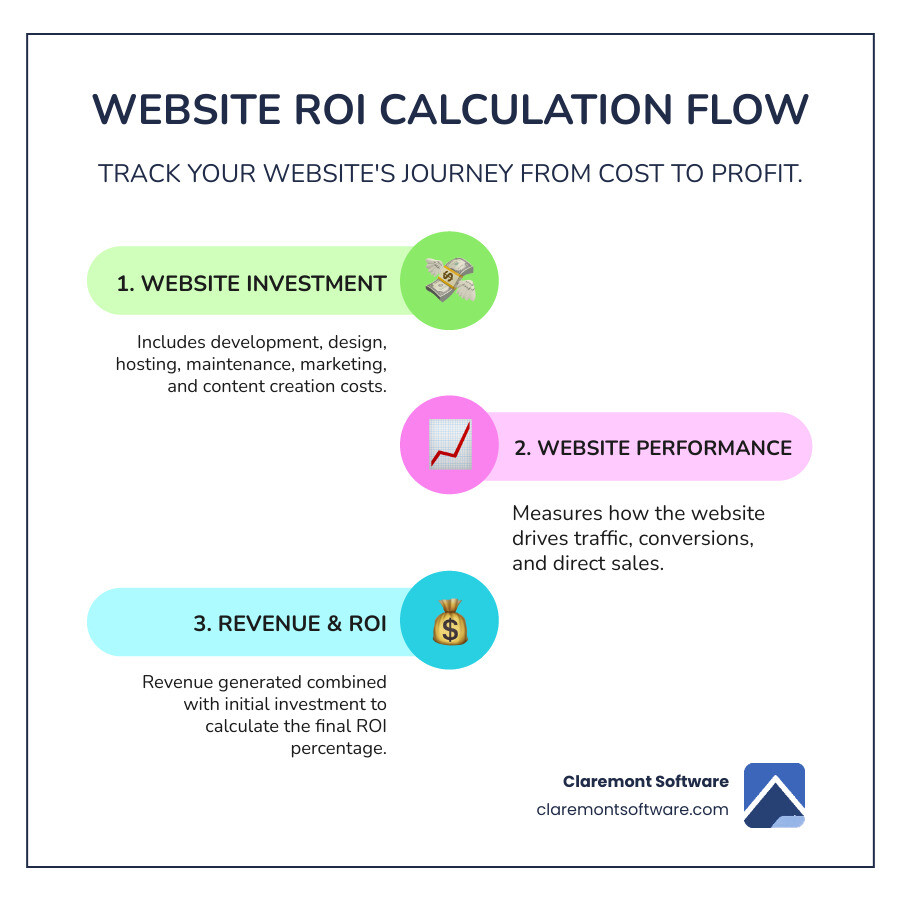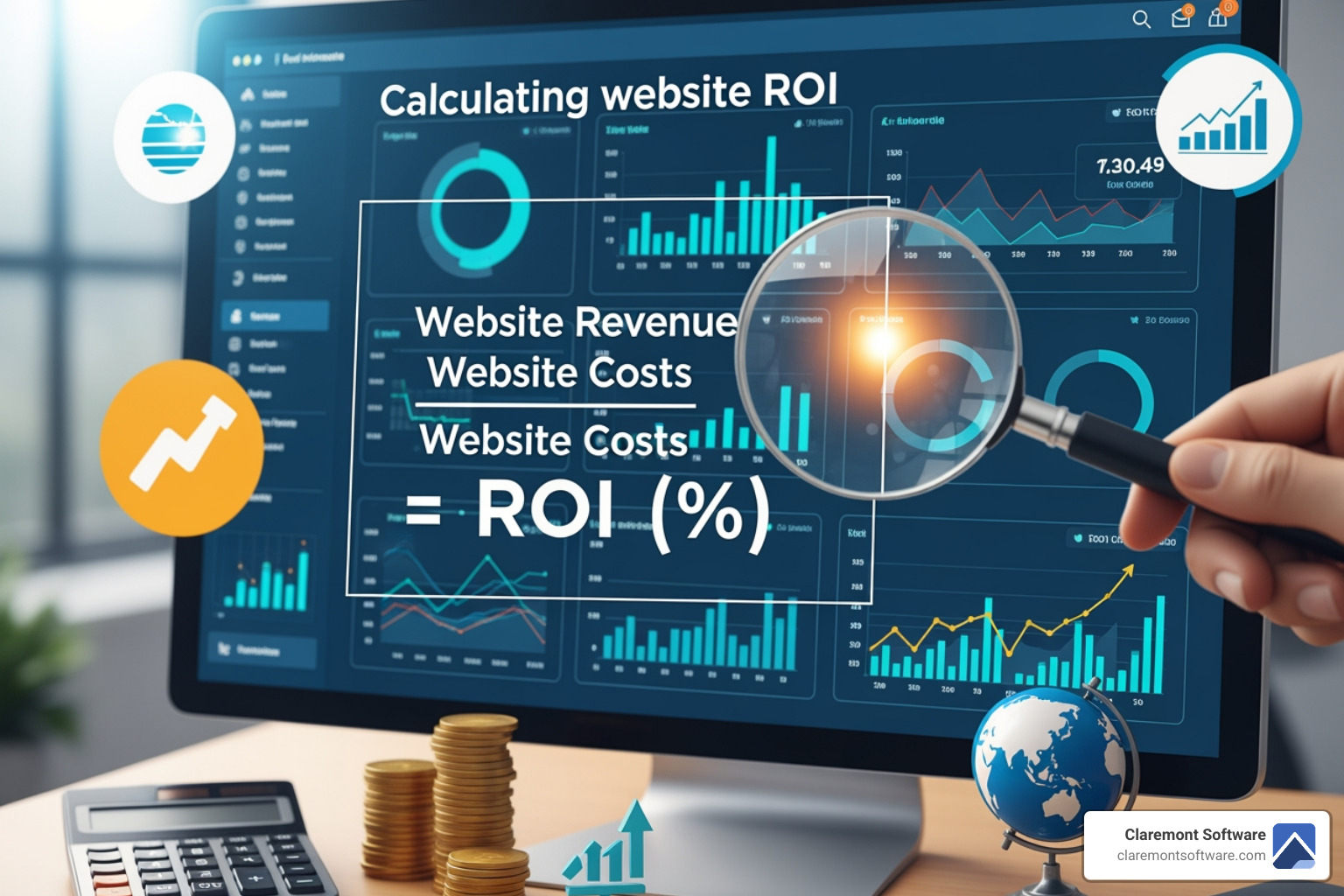Why Your Website's Return on Investment Matters More Than Ever

Calculate website ROI to determine if your website is a profitable asset or a costly liability. Here's the quick answer:
Website ROI Formula:
ROI = (Revenue Generated - Website Costs) / Website Costs × 100 What You Need:
- Revenue Generated: E-commerce sales, lead value, subscriptions, ad revenue.
- Website Costs: Development, hosting, maintenance, marketing, content.
- Time Period: Use the same timeframe for both revenue and costs.
Example: A website generating $250,000 in revenue with $130,000 in costs has an ROI of 92.3%.
You've been told you need a professional website, but the real secret is that your website should make you money, not just cost you money. Businesses that achieve impressive returns—some seeing payback in just 18 days—treat their website as a measurable investment, not a digital brochure.
While others track vanity metrics like page views, smart business owners focus on what matters: traffic that converts, leads that close, and revenue that grows. Your competitors are already calculating their website ROI and using data to make decisions. It's time to stop guessing if your investment was worth it.
I'm James Smith, and for 25 years, I've built websites that deliver measurable returns. The businesses that thrive online know how to calculate website ROI and use that data to drive growth. Let me show you how.

The Core Formula: How to Calculate Website ROI
Calculating website ROI isn't complex. It's the same metric you'd use for any business investment, telling you how much profit you're making for every dollar spent.
The formula is:
ROI = (Revenue Generated - Website Costs) / Website Costs × 100 A positive ROI means your website is profitable. For example, if your site generates $50,000 in revenue and costs $25,000, your ROI is 100%—you've doubled your money. At Claremont Software, we focus on turning your website into a profitable asset.
Identifying Your Website's "Return" (Revenue)
Your website's revenue comes from multiple sources. To calculate ROI accurately, you must track all of them.
- Direct Sales: Revenue from e-commerce transactions made on your site.
- Lead Value: For service businesses in Lake County, IL, this is crucial. If your site generates 10 leads a month, you close 20%, and each client is worth $5,000, that's $10,000 in monthly revenue attributed to your website.
- Ad & Subscription Revenue: Money earned from hosting ads or from recurring membership/SaaS fees.
- Customer Lifetime Value (LTV): The total revenue a customer generates over their entire relationship with your business. A site attracting high-LTV customers is incredibly valuable.
The key is revenue attribution—using analytics to understand how your website contributes to each sale, even if it's just one step in a long customer journey.
Tallying Up Your Website's "Investment" (Costs)
Your website's true cost goes beyond the initial build. It includes all ongoing expenses required to keep it running and effective.
- Development & Design: The initial cost to plan, design, code, and launch the site.
- Hosting & Maintenance: Ongoing fees for servers, security updates, and technical support. Our Website Care Plans cover these essentials.
- Marketing & Ad Spend: Costs for Google Ads, social media advertising, and other traffic-driving efforts.
- Content Creation: The investment in blog posts, videos, and other materials that attract and engage visitors.
- Staff Time: The salary cost of employees who manage, update, or analyze your website.
- Software & Tools: Subscriptions for analytics, CRM, and email marketing platforms.
Understanding the full scope of your investment is essential. Our guide on How Much Should a Small Business Website Cost in 2025? can help you budget accurately.
Common Mistakes to Avoid When You Calculate Website ROI
Avoid these common pitfalls to ensure your calculations are accurate and lead to smart business decisions:
- Inconsistent Timeframes: Always measure revenue and costs over the exact same period.
- Ignoring Indirect Revenue: Don't forget the value of phone-call leads or brand-building that results in a future sale.
- Forgetting Ongoing Costs: Include all recurring expenses like hosting, marketing, and maintenance, not just the initial build cost.
- Focusing on Vanity Metrics: Page views don't pay the bills. Focus on conversions, qualified leads, and revenue.
- Poor Attribution Modeling: Acknowledge the website's role throughout the entire customer journey, not just the final click.
Boosting Your Bottom Line: Strategies to Improve Website ROI
Knowing your ROI is the first step; improving it is where the magic happens. A low ROI isn't a failure—it's a roadmap for optimization. By continuously measuring, analyzing, and optimizing, you can transform an average website into a profit-generating machine.
The Power of Optimization: CRO and SEO
Two strategies deliver the biggest impact on website ROI: Conversion Rate Optimization (CRO) and Search Engine Optimization (SEO).

- Conversion Rate Optimization (CRO) focuses on getting more of your existing visitors to take action—buy a product, fill out a form, or make a call. Even a small increase in your conversion rate, like from 2% to 2.5%, can boost your leads by 25% without any additional ad spend. If you have traffic but no leads, you have a conversion problem. Our guide on Why Your Website Isn't Bringing You Leads and How to Fix It can help.
- Search Engine Optimization (SEO) brings more of the right visitors to your site—people actively searching for your services. This qualified traffic is more likely to convert, boosting ROI. When someone in Libertyville searches for "website redesign Lake County," SEO ensures you show up. Avoiding common pitfalls is key, which we cover in 5 Common SEO Mistakes Local Businesses Make and How to Fix Them.
Combining CRO and SEO creates a powerful growth engine: you attract the right people and ensure they convert.
Enhancing User Experience (UX) and Mobile-Friendliness
A website's design directly impacts your bottom line. Good User Experience (UX) guides visitors smoothly toward a purchase, while a frustrating site sends them to your competitors. Focus on these key areas:
- Clear Navigation: Users should instantly understand how to find what they need.
- Fast Page Speed: Slow-loading sites lose visitors and sales. Every second counts.
- Strong Calls-to-Action (CTAs): Use clear, action-oriented language like "Get Your Free Quote" instead of a vague "Learn More."
- Mobile-Friendliness: With over half of web traffic coming from mobile devices, a site that isn't mobile-friendly is losing more than half its potential ROI. Google's mobile-first indexing also means a poor mobile site hurts your search rankings. We design every website with a mobile-first approach to maximize returns.
Leveraging Tools and Calculators for Optimization
You can't improve what you don't measure. Data-driven decisions are key to achieving high ROI.
- Performance Monitoring: Tools like Google Analytics 4 and Google Search Console show you where traffic comes from and how users behave.
- User Behavior Analysis: Heatmap tools like Hotjar and Microsoft Clarity provide visual insights into where users click, scroll, and get stuck.
- A/B Testing Software: Take the guesswork out of optimization by testing different headlines, buttons, and layouts to see what converts best.
- Interactive Calculators: Engage visitors and capture leads by offering value, such as a simple ROI calculator for quick estimates.
Using these tools systematically allows you to measure, analyze, and optimize in a continuous cycle that drives profit.
Advanced ROI Concepts for Strategic Growth
Once you've mastered the basics, it's time to think bigger. Strategic growth requires understanding the deeper patterns that separate a good website from a truly profitable one.

Short-Term Wins vs. Long-Term Value
Not all ROI is created equal. A smart strategy balances immediate gains with sustainable growth.
- Short-Term Wins: These come from actions like paid ad campaigns or quick CRO tweaks. They can deliver measurable ROI within days or weeks, providing immediate cash flow. We've seen clients achieve payback in just 18 days with the right optimizations.
- Long-Term Value: This is the compound interest of the digital world, built through SEO and content marketing. A blog post may take months to rank on Google, but it can generate free, qualified leads for years, building brand credibility and reducing your reliance on paid ads.
Modern web solutions accelerate both, allowing for rapid deployment and testing to capture short-term wins while building a strong foundation for long-term organic growth.
How to Calculate Website ROI for Different Business Models
The ROI formula is universal, but how you define "revenue" depends on your business model. An e-commerce store's success metrics are very different from a local service business in Lake County, IL.
| Business Model | Primary Revenue Focus | Key Metrics for ROI Calculation |
|---|---|---|
| E-commerce | Direct sales of products | Conversion Rate, Average Order Value (AOV), Customer Lifetime Value (LTV) |
| Service-Based | Lead generation, client acquisition | Lead-to-Client Conversion Rate, Average Client Value, Cost Per Lead |
| SaaS | Subscriptions, user sign-ups | Customer Acquisition Cost (CAC), Monthly Recurring Revenue (MRR), Churn Rate |
Understanding your model is critical. An e-commerce site obsesses over cart abandonment, while a service business focuses on form completions and call tracking.
Beyond the Numbers: Intangible Returns
Some of the most significant returns don't fit neatly into a spreadsheet. Don't overlook these intangible benefits when evaluating your website's total value:
- Brand Awareness & Credibility: A professional website builds trust and positions you as a legitimate, established business.
- Customer Satisfaction: An easy-to-use site that helps customers find information or get support saves them time and frustration, fostering loyalty.
- Market Authority: High-quality content establishes you as an expert, attracting more visitors and building trust.
- Internal Efficiency: Automating tasks like appointment scheduling or answering FAQs saves your team time and money.
- Competitive Advantage: In a crowded market, a superior website is often the deciding factor that makes a customer choose you over a competitor.
These intangibles build long-term business value and are often the difference between a website that is merely profitable and one that transforms your business.
Introduction

Calculate website ROI to understand whether your website is an asset or a liability. Here's the quick answer:
Website ROI Formula:
ROI = (Revenue Generated - Website Costs) / Website Costs 100 What You Need:
- Revenue Generated - E-commerce sales, lead value, subscriptions, ad revenue
- Website Costs - Development, hosting, maintenance, marketing, content creation
- Time Period - Use the same timeframe for both revenue and costs
Example: If your website generates $250,000 in revenue and costs $130,000 to build and maintain, your ROI is 92.3%.
Your website should make you money, not just look good. Top performers treat their site as a measurable investment, track conversions (not vanity metrics), and optimize based on data. Your competitors already do this. I'm James Smith, and after 25 years building ROI-focused sites, I'll show you how to measure and improve yours.
The Core Formula: How to Calculate Website ROI
Calculating website ROI is straightforward:
ROI = (Revenue Generated - Website Costs) / Website Costs 100 A positive ROI means the site is profitable; a negative ROI signals it needs work. Our goal at Claremont Software is to make your website a self-funding, profit-generating asset.
Identifying Your Website's "Return" (Revenue)
Your sites return can include:
- Direct sales (e-commerce transactions).
- Lead value for service businesses. Example: 10 qualified leads/month 20% close rate $5,000 average client value = $10,000/month.
- Ad and subscription revenue from memberships or SaaS.
- Customer Lifetime Value (LTV), capturing the total value per customer over time.
- Revenue attribution using analytics to credit the websites role across the full journey.
Tallying Up Your Website's "Investment" (Costs)
Account for all costs, not just the initial build:
- Development and design for planning, UI, coding, and launch.
- Hosting and maintenance (security, updates, support). Our Website Care Plans cover these essentials.
- Marketing and ad spend (search, social, email) to drive traffic.
- Content creation (copy, blogs, video, images) that builds trust and demand.
- Staff time for updates, analytics, and sales follow-up.
- Software/tools (analytics, CRM, email platforms). For budgeting, see How Much Should a Small Business Website Cost in 2025?
Common Mistakes to Avoid When You Calculate Website ROI
- Inconsistent timeframes between revenue and costs.
- Ignoring indirect revenue from calls or assisted conversions.
- Forgetting ongoing costs (hosting, marketing, maintenance).
- Chasing vanity metrics instead of conversions and revenue.
- Poor attribution that undervalues multi-touch journeys.
Boosting Your Bottom Line: Strategies to Improve Website ROI
Once you measure ROI, improve it through a simple cycle: measure, analyze, optimize, repeat. Small gains compound into big returns.
The Power of Optimization: CRO and SEO
- Conversion Rate Optimization (CRO) gets more value from current traffic. If 1,000 monthly visitors convert at 2% (20 leads) and you lift that to 2.5% (25 leads), thats a 25% lead increase with no extra ad spend. If you have traffic but no leads, see Why Your Website Isn't Bringing You Leads and How to Fix It.
- Search Engine Optimization (SEO) brings more qualified visitors who are likely to convert. Avoid pitfalls with 5 Common SEO Mistakes Local Businesses Make and How to Fix Them.
Together, SEO and CRO create a growth engine: attract the right people and convert more of them.
Enhancing User Experience (UX) and Mobile-Friendliness
- Clear navigation that quickly guides users to actions.
- Fast page speed to prevent drop-offs and lost sales.
- Strong, visible CTAs like "Get Your Free Quote."
- Mobile-first design to protect rankings and conversions.
Leveraging Tools and Calculators for Optimization
- Performance monitoring: Google Analytics 4 and Google Search Console.
- Behavior insights: Hotjar and Microsoft Clarity heatmaps and recordings.
- A/B testing: validate headlines, CTAs, layouts with data.
- Interactive calculators: capture leads and educate with simple ROI or savings estimates.
Use these tools in a continuous loop to systematically raise ROI.
Advanced ROI Concepts for Strategic Growth
Moving beyond the basics means balancing quick wins with compounding long-term gains.
Short-Term Wins vs. Long-Term Value
- Short-Term Wins: Paid campaigns and quick CRO/UX fixes can show ROI in days or weeks. Some clients see payback in as little as 18 days.
- Long-Term Value: SEO and content can take 612 months but deliver durable, low-cost leads and brand authority.
Modern web solutions speed both tracks, often yielding average ROIs near 300% with payback periods around 30 days when executed well.
How to Calculate Website ROI for Different Business Models
| Business Model | Primary Revenue Focus | Key Metrics for ROI Calculation |
|---|---|---|
| E-commerce | Direct sales of products | Conversion Rate, Average Order Value (AOV), Customer Lifetime Value (LTV) |
| Service-Based | Lead generation, client acquisition | Lead-to-Client Conversion Rate, Average Client Value, Cost Per Lead |
| SaaS | Subscriptions, user sign-ups | Customer Acquisition Cost (CAC), Monthly Recurring Revenue (MRR), Churn Rate |
Know your model so you can optimize for the right outcomescart flows for e-commerce, form/call conversions for services, and sign-up-to-paid funnels for SaaS.
Beyond the Numbers: Intangible Returns
- Brand credibility that improves trust and close rates.
- Better customer experience that drives loyalty and referrals.
- Market authority via helpful content that attracts qualified demand.
- Internal efficiency through self-serve FAQs and automation.
- Competitive advantage in Lake County, IL from a clearly superior site.
These intangibles compound your measurable ROI over time.
Frequently Asked Questions about Website ROI
Here are answers to common questions from small businesses in Lake County, IL.
What is a good ROI for a website?
Any positive ROI is profitable. Many businesses can target 300%+ over time$4 back for every $1 investedand some see payback in as little as 18 days. The core question: does your site generate more revenue than it costs?
How long does it take to see ROI from a new website?
- Short term (3090 days): Paid ads and quick CRO fixes can deliver fast returns.
- Long term (612+ months): SEO and content compound, lowering acquisition costs. Track ROI monthly early on, then quarterly to guide adjustments.
My website gets traffic but no leads. What's wrong?
Its a conversion issue: UX friction, weak CTAs, mismatched messaging, or the wrong audience. Start with a focused audit; we outline fixes here: Why Your Website Isn't Bringing You Leads and How to Fix It.
Conclusion: Turning Your Website into a Profit Center
Your website isnt a brochureits an asset that should produce measurable returns. When you calculate ROI regularly, you can double down on what works, fix what doesnt, and create predictable growth.
At Claremont Software, we design and optimize sites that convert visitors into customers, helping small businesses in Gurnee, Libertyville, and across Lake County, IL turn websites into reliable revenue engines.
Ready to make your website pay for itself? Explore our Web Design Services.
